In about nine years of photographing birds I’ve never found an American Bittern out in the open. Until last week. Bitterns may be the most secretive and shy avian species I try to photograph because they spend nearly all of their time buried deeply in tall wetland vegetation and seldom come out. Their very effective cryptic coloration doesn’t help and they’re uncommon to boot.
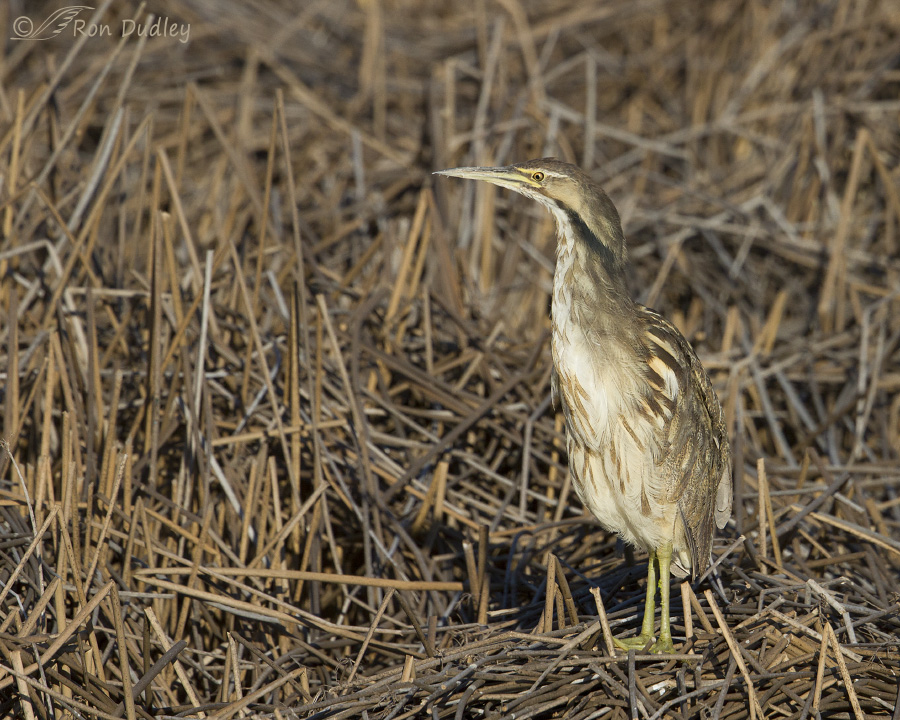
1/3200, f/6.3, ISO 400, Canon 7D, Canon EF 500mm f/4L IS II USM + 1.4 tc, not baited, set up or called in
But last Friday I spent almost five minutes with this one at Bear River Migratory Bird Refuge. The bird was entirely exposed and didn’t seem to care which surprised me immensely. The setting it was in doesn’t make for pretty pictures but at this point I don’t care a whit about that.
If you’re ever lucky enough to see one of these birds there should be no confusing it with another species – American Bitterns are the only heron with that long black patch running down the side of the neck (in adults).
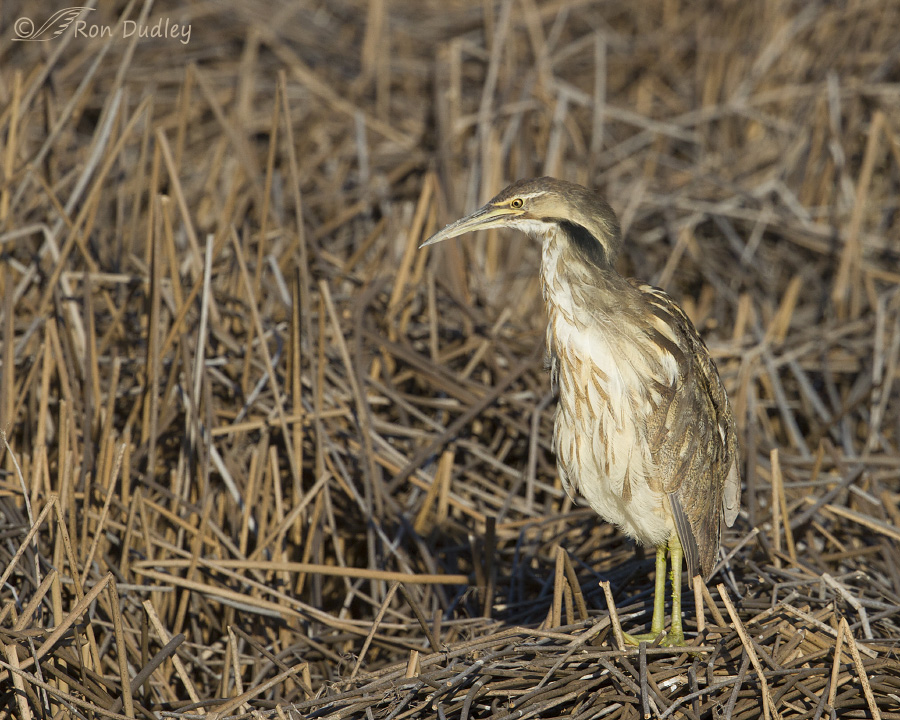
1/2500, f/6.3, ISO 400, Canon 7D, Canon EF 500mm f/4L IS II USM + 1.4 tc, not baited, set up or called in
This bittern was completely at ease and it spent much of its time preening. As it did so it revealed a plumage feature I was unaware of in this species – it had extremely long feathers coming off the back of its head. Those feathers (I hesitate to call them a “crown”) were often raised off of the back of its neck which gave the bird a bit of a goofy look.
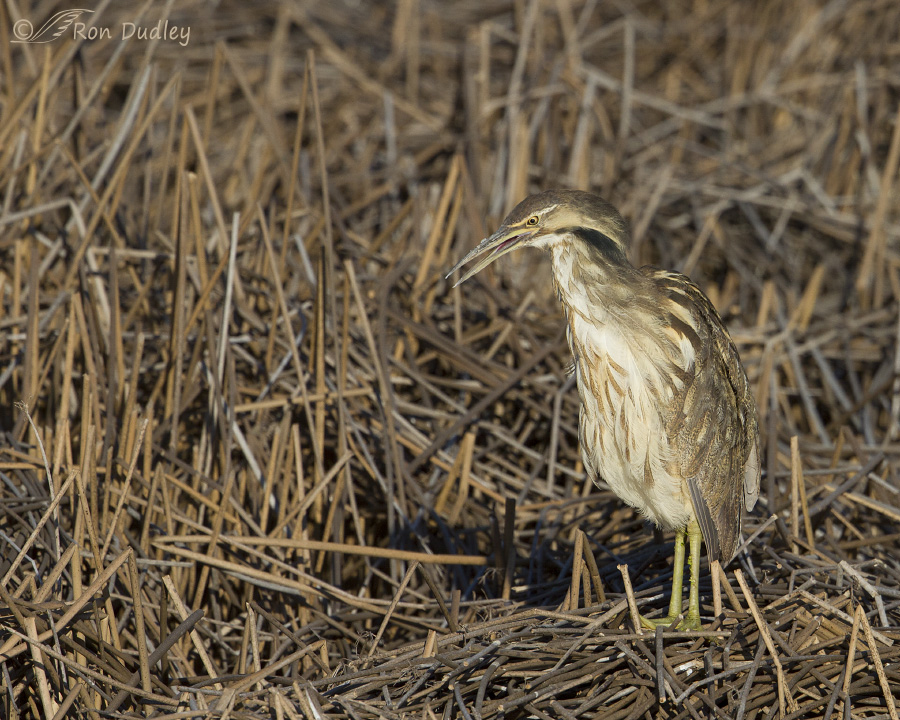
1/3200, f/6.3, ISO 400, Canon 7D, Canon EF 500mm f/4L IS II USM + 1.4 tc, not baited, set up or called in
It held those feathers up for quite a while as it preened and when it felt the need to scratch its chin…
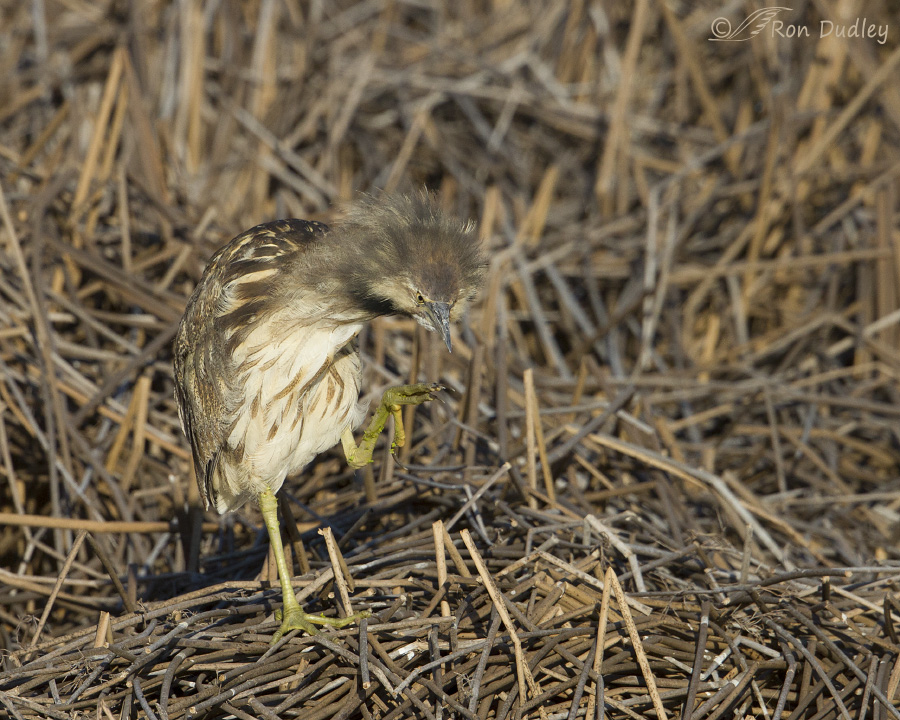
1/2500, f/6.3, ISO 400, Canon 7D, Canon EF 500mm f/4L IS II USM + 1.4 tc, not baited, set up or called in
those feathers were fanned out and pulled forward which was so unexpected that it made me literally laugh out loud as I was firing away with my camera.
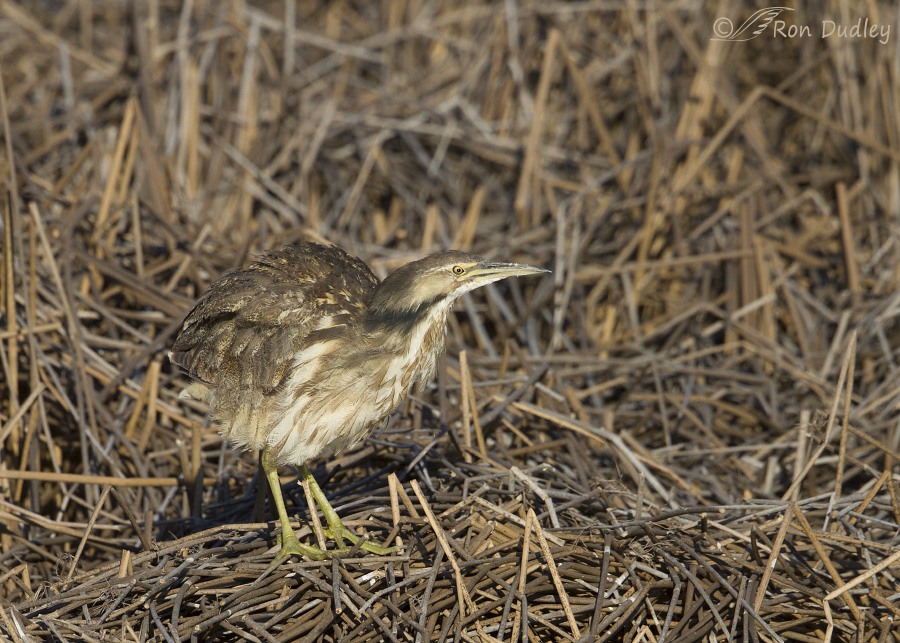
1/2500, f/6.3, ISO 400, Canon 7D, Canon EF 500mm f/4L IS II USM + 1.4 tc, not baited, set up or called in
Something else surprised me about the behavior of this bird. When it was through preening it turned to its left…
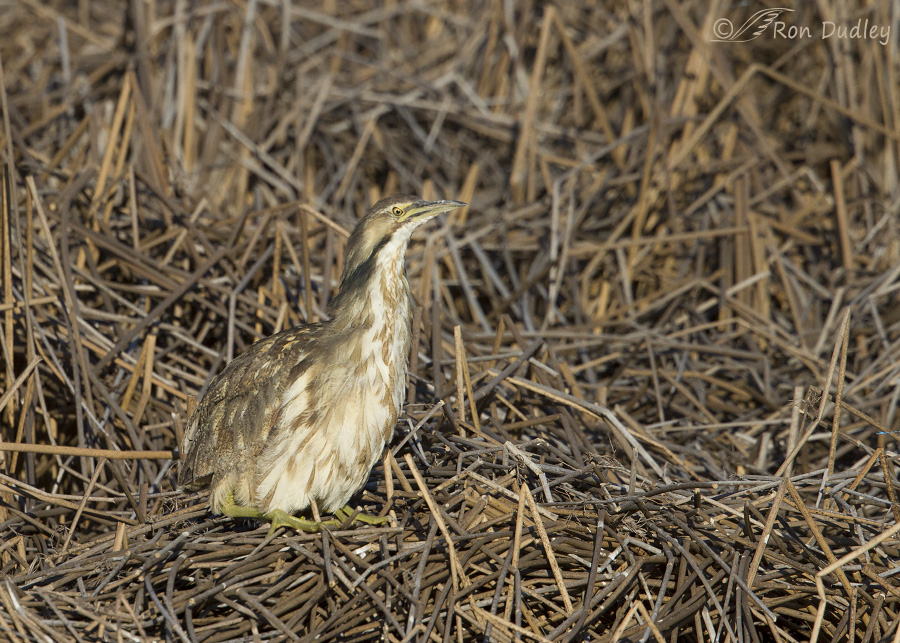
1/2500, f/6.3, ISO 400, Canon 7D, Canon EF 500mm f/4L IS II USM + 1.4 tc, not baited, set up or called in
and squatted down to defecate. I’m not sure why that surprised me but it did and it made me think of a dog doing the same thing.
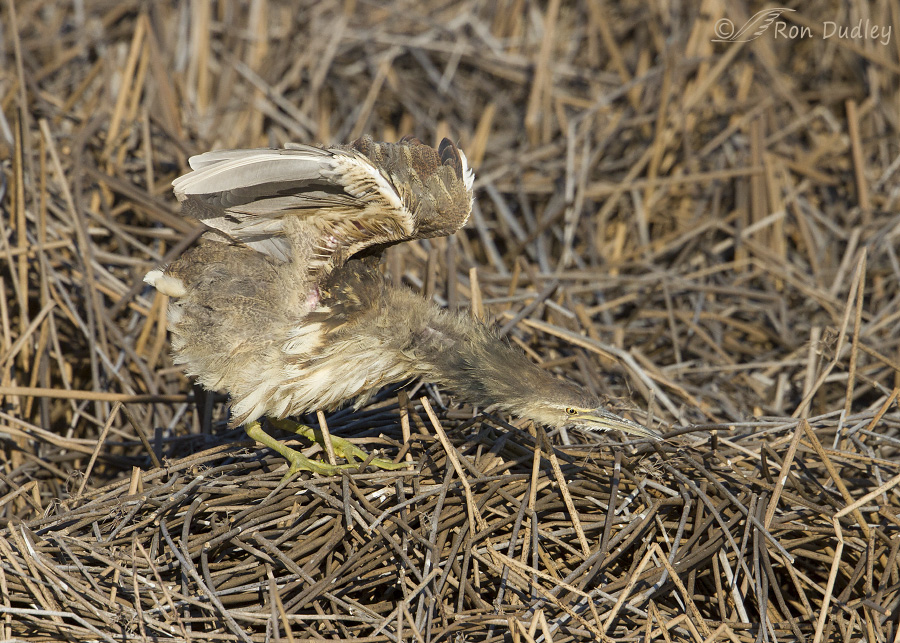
1/2500, f/6.3, ISO 400, Canon 7D, Canon EF 500mm f/4L IS II USM + 1.4 tc, not baited, set up or called in
Then the bird was kind enough to give me a nice wing stretch before it…
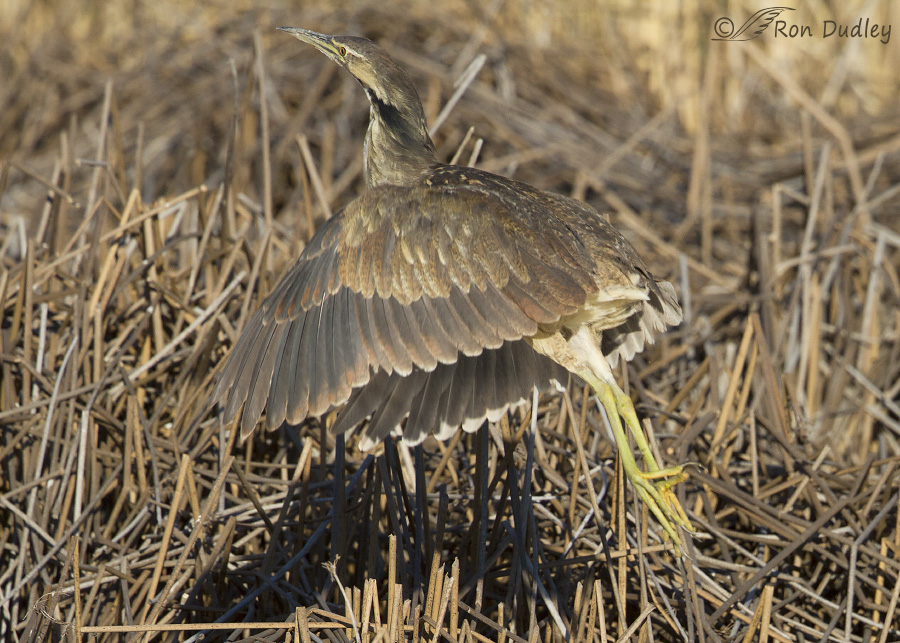
1/2500, f/6.3, ISO 400, Canon 7D, Canon EF 500mm f/4L IS II USM + 1.4 tc, not baited, set up or called in
turned to its right and took off away from me (and I almost cut off its head). I very rarely see photos of bitterns in flight so I sure wish it had taken off more in my direction.
Some readers might not be fully appreciative of my excitement about finding a bittern out in the open so I’m going to include some statements from Birds of North America Online regarding how difficult their secretive ways make it to study them and learn their habits (and photograph them):
- “Because of this species’ secretive nature and inaccessible habitats, remarkably little is known about basic aspects of its biology, including sources of mortality, habitat use, mating systems, and population structure. Basic research on its natural history would help to conserve the species, which is undergoing substantial declines over much of the U.S. owing largely to loss and degradation of wetland habitats.”
- “No information on preening, head scratching, stretching, bathing, sunbathing, thermoregulation, temperature metabolism, sleeping, or roosting. Little information on timing of daily activities.”
- “Little information on interactions with members of other species.”
- “No information on territorial behavior or spacing of nests.”
- “Extra-Pair Copulations – No information.”
Yes, I wish I’d found this bittern in a more attractive setting. But I now have some detailed images of the species out in the open in natural habitat and some of them even show interesting behaviors. It would be greedy of me to ask for more.
Ron


Lovely shots. I especially like the last one.
Thank you, Jean.
Beautiful shots you got Ron!
I have to share my bittern story…A couple years ago, as we were coming back from a long weekend in the UP I happened to spot one in the reeds along side the road. Thankfully we were the only ones on the road as I hit the brakes for a very quick stop to turn around. My wife and daughter asking what was wrong and if I’m trying to kill them in some very, uh…”colorful” language while I’m excitedly ‘yelling’ back that I saw a bittern in the reeds. We were able to get some decent shots of it with it’s head up trying to blend in. All was well with both the wife and daughter once I pointed out the bittern. We still get a good laugh over that!
I’ve had some screeching stops for birds that upset my passengers too, Jeff – you do what you have to!
Woo Hoo.
Love those green legs too.
And the do.
I am so glad you met an extrovert Bittern.
Good eye noticing those greenish legs, EC. They’re known for them.
Great series Ron. They literally are the ghosts of the marsh. But you know they’re there because their call is so distinctive and loud!
It sounds like you hear them much more often than I do, Larry. I’ve rarely done so…
Yep, I’m right with you! Each spring we have a male who comes to our marsh and retention pond to call for a mate. The most we have had is two males vying for one female. However, after the initial calls for a month, they are so secretive they in fact could either nest or leave and I wouldn’t know.
I get excited each year when they arrive because they are so secretive and as you said it is extremely difficult to view them.
Great shots, thanks for sharing.
Ok, Dick, I came through for you with images of a weasel recently so my challenge for you is to photograph one of your bitterns!
I’ll accept that challenge, but that can’t happen till next year. They have been gone since the beginning of July!
I have a blind and will set up next spring and see if I can send you an image. Full of vim and vinegar, but not sure how successful I’ll be.
I like your spunk for accepting the challenge. Good luck!
Swamps have always been among my favorite stamping(sloshing?) grounds and, as far as I know, i’ve never seen one in the wild…though they may have been right under my nose…”hiding” in plain sight….y
I’ll bet they have been, Patty – multiple times.
Love this series! Will you be sending it to Audubon or Cornell since so little is known about their behavior?
Thanks, Gail. In my experience both groups prefer to get that kind of behavioral info from bona fide researchers.
I agree with Susan stone. I like birds in their natural habitat. All the colors blend well. I have never seen a bittern. Never even heard of it till your post
I keep learning from you. Thank-you. Never knew what the pellets were on my back deck till I read your series on the kestrals .
Good, I’m glad you’re picking up some useful informational tidbits, Marina. Thanks for that feedback.
What a unique opportunity! We see them here only during migration and I’ve spent a lot of time staring at reeds wondering if I’m looking at a bittern.
“I’ve spent a lot of time staring at reeds wondering if I’m looking at a bittern.”
Ha, that’s it exactly, Wally! Their cryptic coloration is amazingly effective in typical habitat.
Nice! A long time since I spotted, or even heard an American Bittern. Great series!
Thank you, Jane.
I’ve never seen an American Bittern before but have photographed a Bittern in the Pantanal. That Bittern was extremely colorful. Is the American version more colorful in mating season or are they simply not as colorful as the SA version?
John, I believe our bitterns look about the same year-round.
Hi Ron,
Congratulations on your find. I had the same feelings in June at Bear River Migratory Bird Refuge when I saw my first Clark’s Grebes with babies on their backs and doing their “mating dance.” Given the habitat there, I’m a bit surprised at how rare they are. eBird shows no American Bitterns in the area around the refuge. In my area (Western Washington) a reliable place to see them is Nisqually Wildlife Refuge. Over the past 8 years I’ve taken photos of them eating frogs, fish, meadow voles, and a salamander. Perhaps because there are no roads at Nisqually and you have to walk the trails, they are more habituated to humans and not as flighty. I have full frame photos of one stalking, catching, and eating a frog literally at my feet taken at 78mm. In addition to raising the feathers on their head, they will puff out the feathers on their chest, perhaps to look larger.
Wow, that was a cooperative bittern to the extreme, John!
Just further proof that there’s no substitute for putting in time in the field. Congratulations, Ron. As well as capturing some great photos, you’ve added some interesting information to what was previously known about this species.
I can’t get over how beautifully camouflaged these birds are…hard to see even when you know exactly where to look and what you’re looking at. In the fourth frame, you can see where some of the pow wow traditional dancers get their inspiration …that bird looks just like one..just minus the bright colored regalia….I can almost hear the heartbeat of the big pow wow drum….
Patty, their camo is incredible, especially when they mimic the reeds they’re in by standing erect with their bill pointed upward and swaying and leaning in the breeze in the same direction the reeds are leaning. You can look at them, look away, and then look back and not be able to see them even though they haven’t moved.
Congratulations
In march 2013 I had the pleasure to see and photograph a Great Bittern on ice in Sweden
Thank you.
Wow!!!!! Sensational series, Ron! Bitterns are so tough to detect and so well hidden that I cringe to think how many I may have missed even when that was the bird I was looking for the most! They have mastered the ability to disappear into their surroundings. Amazing to see a series like this- well done!
Makes me wonder how many of them I’ve barely missed too, Diane. Bet there’s been a fair number of them…
It is always a real treat to get to see one of these elusive birds. Wonderful series.
Thank you, Jo.
How elegant! Oh WOW! Like so many others, I’ve never seen American Bitterns, so what a blessing it is to see these wonderful shots! THANK YOU!
And yes, life is oftentimes messy and glorious in its diversity and ability to shelter everyone somewhere.
Since they’re so secretive and so little is known about them, have you thought about sharing your photos with folks like Birds of North America?
Thanks, Laura. I suspect BNA has all the photos of bitterns they can use. Because they’re such a desired photographic quarry a lot of good bird photographers spend much of their time trying to get photos and many of them are eventually successful.
I particularly love that 4th photo! I was lucky enough to see one fly from one side of a marsh to the other three times while birding in a marshy area near Stanley, ID! I couldn’t believe it. My only other sighting was a quick glimpse as it poked itself out of some reeds.
I’m nor sure I’ve ever seen one in flight, Kathy, except for this one after it took off.
WOW! Wonderful series of the Holy Grail of Birds! I know how exciting this is. I once was privileged to see one catch not one but 2 Fish! So glad you were able to get threshold fantastic Shots!
Charlotte
Thanks very much, Charlotte.
WOW!:) The one with its fanned out feathers almost looks like it was irritated about something! Imagine it was a bit of a focusing challenge with it blending well into the background. GREAT catch, Ron.
Imagine it was a bit of a focusing challenge with it blending well into the background. GREAT catch, Ron. 
Yes, it was a focusing challenge, Judy – there just wasn’t much contrast between bird and background. Thank you.
An absolutely amazing series of a bird that is difficult to *see* much less photograph. I’m used to nothing more than fleeting glimpses. Thanks for being there and capturing these moments, Ron.
I can tell you “get it”, Gretchen. These birds are elusive…
These shots are simply wonderful! I’ve never had the pleasure of seeing an American Bittern, so I’m excited that you were able to spend such quality time with this one. Given their habits and natural habitat, the background is exactly what one would expect – especially from a nature photographer who prefers to photograph his subjects in their natural habitats… ;-D
Susan, Nature isn’t pretty sometimes but if it’s natural I’ll take it – still beats the heck out of a “hand of man” setting, pretty or not…